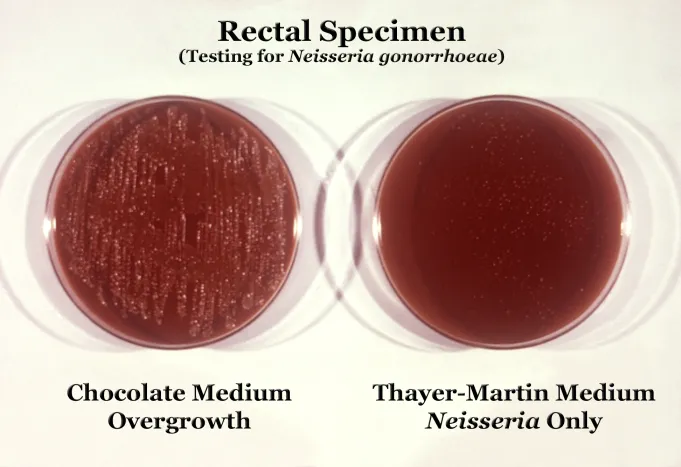Types of culture media
- Enrichment culture media: provides optimal conditions for general bacterial growth
- Selective culture media
- Used to grow only select bacteria and thus to isolate specific pathogens
- Contain substances (e.g., antibiotics) that prevent the growth of other organisms
- Example: Thayer-Martin agar
- Indicator media (differential media)
- Contain indicator substances that undergo a change in color when coming in contact with metabolic products of certain organisms
- Example: MacConkey agar
Most common bacterial cultures
| Culture Medium | Type | Key Use & Appearance |
|---|---|---|
| MacConkey Agar | Selective & Differential | - Selects for: Gram-negative bacteria (bile salts & crystal violet inhibit Gram-positives). - Differentiates: Lactose fermenters (e.g., E. coli, Klebsiella, Enterobacter) turn pink. - Non-fermenters (e.g., Salmonella, Shigella, Pseudomonas) remain colorless. |
| Blood Agar | Enriched & Differential | - Differentiates based on hemolysis: - α-hemolysis: Partial lysis, greenish halo (S. pneumoniae, S. viridans). - β-hemolysis: Complete lysis, clear zone (S. aureus, S. pyogenes). - γ-hemolysis: No lysis, no change (Enterococcus). |
| Chocolate Agar | Enriched | - Contains lysed RBCs, releasing factors V (NAD+) and X (hematin). - Grows fastidious organisms: Haemophilus influenzae and Neisseria. |
| Thayer-Martin Agar | Selective & Enriched | - A type of Chocolate Agar with antibiotics (Vancomycin, Polymyxin, Nystatin) to inhibit contaminants. - Specifically isolates: Neisseria gonorrhoeae and N. meningitidis. |
| Mannitol Salt Agar (MSA) | Selective & Differential | - Selects for: Staphylococcus species (thrive in high salt). - Differentiates: S. aureus ferments mannitol, turning the agar yellow. - S. epidermidis does not ferment mannitol (remains pink/red). |
| Hektoen Enteric Agar | Selective & Differential | - Isolates: Salmonella and Shigella from other enterics. - Salmonella: Produces black colonies (due to H2S production). - Shigella: Produces green colonies. |
| Sorbitol-MacConkey Agar | Differential | - Differentiates: E. coli O157:H7 (EHEC) does not ferment sorbitol (colorless colonies) from other E. coli strains (pink colonies). |
| Charcoal Yeast Extract Agar | Enriched | - Contains cysteine and iron. - Required for: Legionella pneumophila. |
| Bordet-Gengou / Regan-Lowe Agar | Enriched | - Contains potato extract, charcoal, blood, and antibiotic. - Used for: Bordetella pertussis. |
| Löwenstein-Jensen / Middlebrook Agar | Enriched | - Used for: Mycobacterium tuberculosis (takes weeks to grow). |
| Eaton Agar | Enriched | - Requires cholesterol. - Used for: Mycoplasma pneumoniae. |
- MacConkey agar
- Contains lactose, bile salts, sodium chloride, and a pH indicator
- Lactose fermenters (e.g., E. coli and Klebsiella)
- Pink colonies (indicator turns pink when pH is lowered due to fermentation of lactose to acidic hydrogen sulfide)
Mnemonic
- Fermentation of lactose → pink colonies on MacConkey agar. Examples include Citrobacter, E coli, Enterobacter, Klebsiella, Serratia.
- McCowkey CEEKS milk.
- Hektoen enteric agar
- Composed of proteose peptone, various sugars (e.g., lactose, sucrose, salicin), sodium thiosulfate, and iron (III) ammonium citrate
- Enteric bacteria (e.g., Salmonella and Shigella)
- Salmonella: black colonies
- Salmonella produces hydrogen sulfide (H2S) using thiosulfate, which results in black colony formation, that can be differentiated from Shigella colonies that do not produce H2S.
- Shigella: green colonies
- Salmonella: black colonies
- Thayer-Martin agar
- Contains the following antibiotics to inhibit growth of other organisms:
- Vancomycin: inhibits growth of gram‑positive bacteria
- Trimethoprim and colistin: inhibit growth of other gram‑negative bacteria
- Nystatin: inhibits growth of fungi
- Neisseria spp.
- Contains the following antibiotics to inhibit growth of other organisms:
- Chocolate agar
- Contains X factor (hematin) and V factor (NAD+) to promote growth of fastidious organisms (organisms with complex or stringent nutritional requirements that are difficult to culture and only grow with specific nutritional supplementation and precise environmental control)

- Made by heating sheep/horse blood to 80 ℃ and lysing RBCs. This releases hemoglobin which turns brown when heated - this is called “chocolate-ing” of the blood.
- Haemophilus influenzae
- Contains X factor (hematin) and V factor (NAD+) to promote growth of fastidious organisms (organisms with complex or stringent nutritional requirements that are difficult to culture and only grow with specific nutritional supplementation and precise environmental control)
- Eosin-methylene blue agar
- A growth medium used to culture and identify Escherichia coli. The medium turns dark purple when colonized by most lactose fermenters and is colorless for lactose nonfermenters. E. coli colonies cultured on the medium have a green metallic sheen.